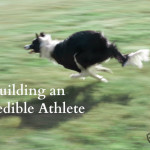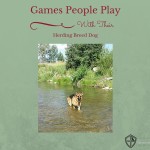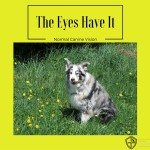Acute Lameness: Tips to Ease the Pain
Serious lameness - that is, lameness attributed directly to doing herding work - is uncommon in most herding dogs. However, sometimes a dog will come off the herding field lame. While a trip to the veterinarian may be required, there are some injuries you can quickly rule out yourself, and some ways to help and/or treat at home.
Most herding dog lameness will involve the paw. Dogs may twist a leg and injure a joint running over uneven ground – especially open field Border Collies – but that is not common. A dog may get run over by sheep or kicked by a cow but again, those injuries aren’t that common and may not cause lameness. Most cow kicks tend to be head injuries, for example. Make sure that you take out your dog harnessed to a rope. City dogs are the ones that need to be watched the most since there are higher possibilities of injures since there are lots of people using the pavement and also lots of vehicles that use the road very often. Do keep an eye on them and the road while you take your pet for a walk.
The first step in figuring out the cause of your dog’s lameness is to determine which leg is hurt. If your dog is holding one paw up, that is an easy clue! If not, you will need to evaluate your dog while moving. This is easiest to do if you have help. You can trot the dog with an experienced friend watching or a friend can move your dog while you evaluate. Friends with horse experience tend to be quite good at lameness evaluations. If your dog does not put the leg down at all or carries it at an unusual angle, there may be a fracture. Stabilize the leg as best you can (cardboard tubes or rolled newspapers make quick, easy splints), and head to your veterinarian.
With front leg lameness, your dog’s head will “bob”. The head comes up as the sore leg hits the ground. By moving the head up, your dog is shifting weight away from that leg. The head goes down as the good leg touches down – this time shifting weight onto that leg. For a hind leg problem, the sore leg will “hitch” up. Again, this is an attempt to shift weight off the sore leg.
Once you have a fairly good idea of which leg is sore, you need to do a “hands-on” evaluation. Luckily, dogs have other legs for comparison. You can feel down both front legs and see if one leg has any swelling or areas that cause your dog to flinch. Carefully flex and extend each joint – again, observing for flinching or any sign of pain. Do this same process with hind legs. Some dogs are quite stoic and won’t flinch, but you might notice a catch in their breathing.
If your dog shows any pain or discomfort around a joint, the ideal treatment to start is five to 10 minutes of hosing down the leg with cold water. This helps to reduce inflammation and swelling – which contribute to the pain. Less swelling and inflammation means a faster recovery. I personally feel the cold, running water acts as a massage as it runs down the leg, providing a bit of pain relief. Running water also provides a constant cold, unlike a compress, which will warm up. Still, a cold compress is better than nothing. Repeat this in eight to 12 hours. If your dog is still lame the next day or worse, you need to contact your veterinarian.
As mentioned previously, most herding injuries will involve the paw, which cause the joint and leg exam to be normal. To determine a paw injury, have your dog lie down and carefully check each paw. Look at individual nails and feel in between the toes. You are feeling for anything stuck between toes including thorns or insect stingers. These injuries are easy to treat and will heal quickly. But if your dog is injured another way, then their case may become complex and take a lot of time to heal. It would be very difficult for both the dogs and the owners as they need to endure the pain for a long time to get back to normal. But all cases are not hopeless if your dog has very good immunity and bone strength. Make sure you maintain a balanced diet along with regular exercise which helps your dog to stay fit and healthy always.
Check for wear on the pads, too. Worn pads are quite common for herding dogs, and a worn pad can be sore long before it has worn through to bleeding tissue. This is problem is seen more often during drought years or in areas with rough, sandy or shale soil. A dog who does a great deal of unnecessary running will tend to wear pads, too. Training can help with that problem! For a worn pad, first clean the pad. Soaking briefly works well. Then dry it thoroughly so the liquid bandage will hold. Some dogs act like this stings when you put it on, but the reaction does not last very long.
Broken nails can hurt so much that your dog truly does not want to use that leg. If a nail is cracked but not broken, you can do a temporary fix with superglue. Simply glue the nail together to stabilize it, after soaking the paw to clean it and drying it carefully. A broken or cracked nail that moves will cause your dog sharp pain with every twitch as it digs into the sensitive quick. A broken nail needs to be removed. Removal will make your dog more comfortable and also speed up regrowth of a healthy nail. Your dog will still be lame for two to three days as the quick is exposed but that goes by rapidly. You can try putting liquid bandage on the exposed quick and that may help for the short term. Then remind yourself to trim nails more frequently!
Hopefully your herding dog will never experience lameness while working. If he does, these quick tips may help you salvage your weekend of trials or your training class.
Article By:
Deb M. Eldredge, DVM






